NRSG258: Surgical Patient Care Assessment and Interventions
VerifiedAdded on 2022/08/29
|9
|2580
|20
Report
AI Summary
This report provides a detailed analysis of the nursing care of a surgical patient, Ted, who underwent bowel resection and colostomy formation. The assessment utilizes the clinical reasoning cycle to address the patient's post-operative complications, including elevated vital signs, nausea, vomiting, abdominal pain, and potential infection and respiratory issues. The report considers the patient's biopsychosocial, spiritual, and cultural factors, including his chronic conditions (heart failure, diabetes, obesity, and gout), and the impact of retirement and widowhood. It outlines the collection of relevant information, problem identification, goal setting, and the implementation of nursing interventions, such as oxygen therapy, positioning, and monitoring of vital signs. The report also includes two pharmacological interventions: Captopril and Furosemide, with their pharmacodynamics, adverse effects, and nursing implications. The conclusion emphasizes the application of the clinical reasoning cycle in providing quality nursing care and improving patient outcomes.
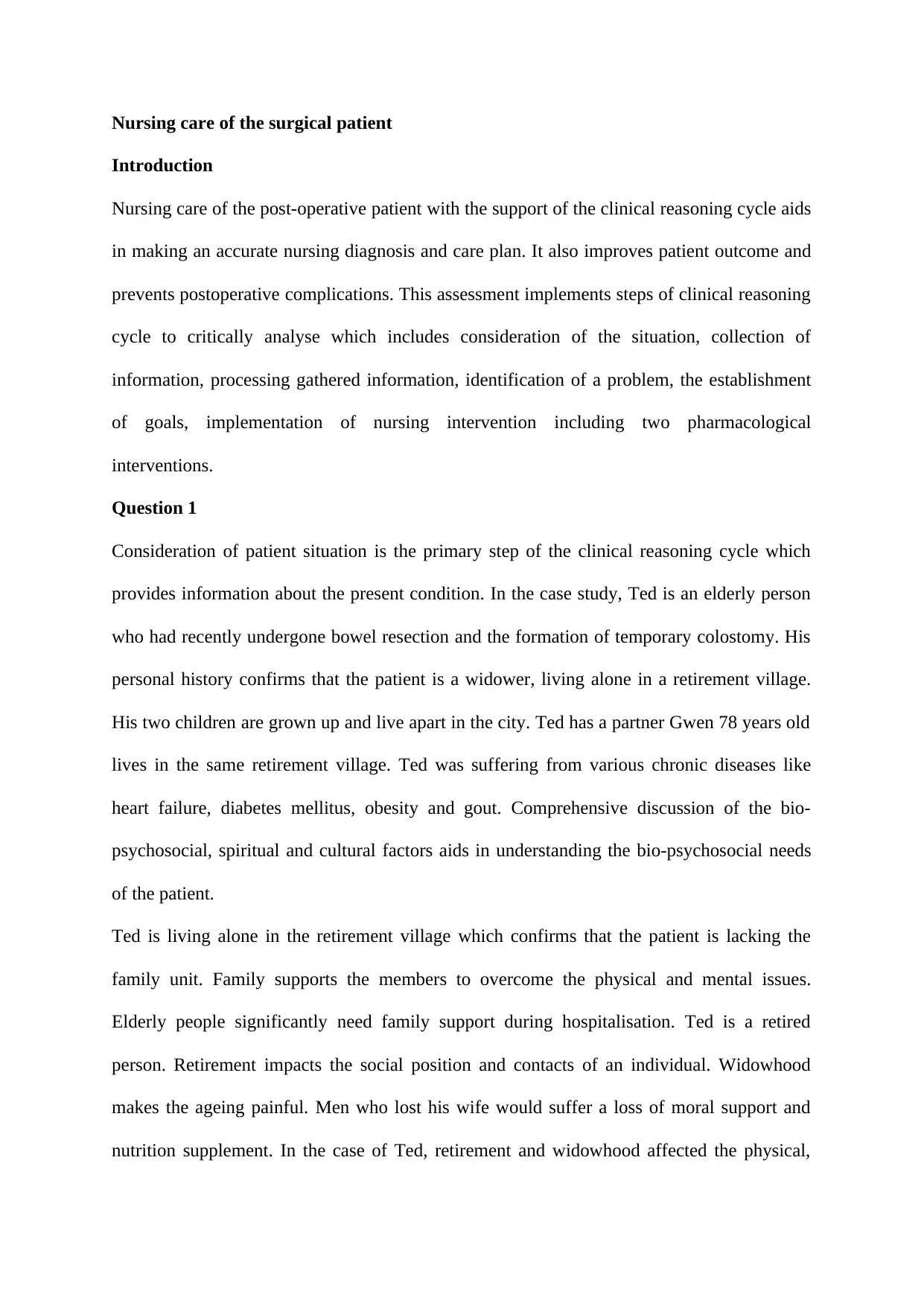
Nursing care of the surgical patient
Introduction
Nursing care of the post-operative patient with the support of the clinical reasoning cycle aids
in making an accurate nursing diagnosis and care plan. It also improves patient outcome and
prevents postoperative complications. This assessment implements steps of clinical reasoning
cycle to critically analyse which includes consideration of the situation, collection of
information, processing gathered information, identification of a problem, the establishment
of goals, implementation of nursing intervention including two pharmacological
interventions.
Question 1
Consideration of patient situation is the primary step of the clinical reasoning cycle which
provides information about the present condition. In the case study, Ted is an elderly person
who had recently undergone bowel resection and the formation of temporary colostomy. His
personal history confirms that the patient is a widower, living alone in a retirement village.
His two children are grown up and live apart in the city. Ted has a partner Gwen 78 years old
lives in the same retirement village. Ted was suffering from various chronic diseases like
heart failure, diabetes mellitus, obesity and gout. Comprehensive discussion of the bio-
psychosocial, spiritual and cultural factors aids in understanding the bio-psychosocial needs
of the patient.
Ted is living alone in the retirement village which confirms that the patient is lacking the
family unit. Family supports the members to overcome the physical and mental issues.
Elderly people significantly need family support during hospitalisation. Ted is a retired
person. Retirement impacts the social position and contacts of an individual. Widowhood
makes the ageing painful. Men who lost his wife would suffer a loss of moral support and
nutrition supplement. In the case of Ted, retirement and widowhood affected the physical,
Introduction
Nursing care of the post-operative patient with the support of the clinical reasoning cycle aids
in making an accurate nursing diagnosis and care plan. It also improves patient outcome and
prevents postoperative complications. This assessment implements steps of clinical reasoning
cycle to critically analyse which includes consideration of the situation, collection of
information, processing gathered information, identification of a problem, the establishment
of goals, implementation of nursing intervention including two pharmacological
interventions.
Question 1
Consideration of patient situation is the primary step of the clinical reasoning cycle which
provides information about the present condition. In the case study, Ted is an elderly person
who had recently undergone bowel resection and the formation of temporary colostomy. His
personal history confirms that the patient is a widower, living alone in a retirement village.
His two children are grown up and live apart in the city. Ted has a partner Gwen 78 years old
lives in the same retirement village. Ted was suffering from various chronic diseases like
heart failure, diabetes mellitus, obesity and gout. Comprehensive discussion of the bio-
psychosocial, spiritual and cultural factors aids in understanding the bio-psychosocial needs
of the patient.
Ted is living alone in the retirement village which confirms that the patient is lacking the
family unit. Family supports the members to overcome the physical and mental issues.
Elderly people significantly need family support during hospitalisation. Ted is a retired
person. Retirement impacts the social position and contacts of an individual. Widowhood
makes the ageing painful. Men who lost his wife would suffer a loss of moral support and
nutrition supplement. In the case of Ted, retirement and widowhood affected the physical,
Paraphrase This Document
Need a fresh take? Get an instant paraphrase of this document with our AI Paraphraser
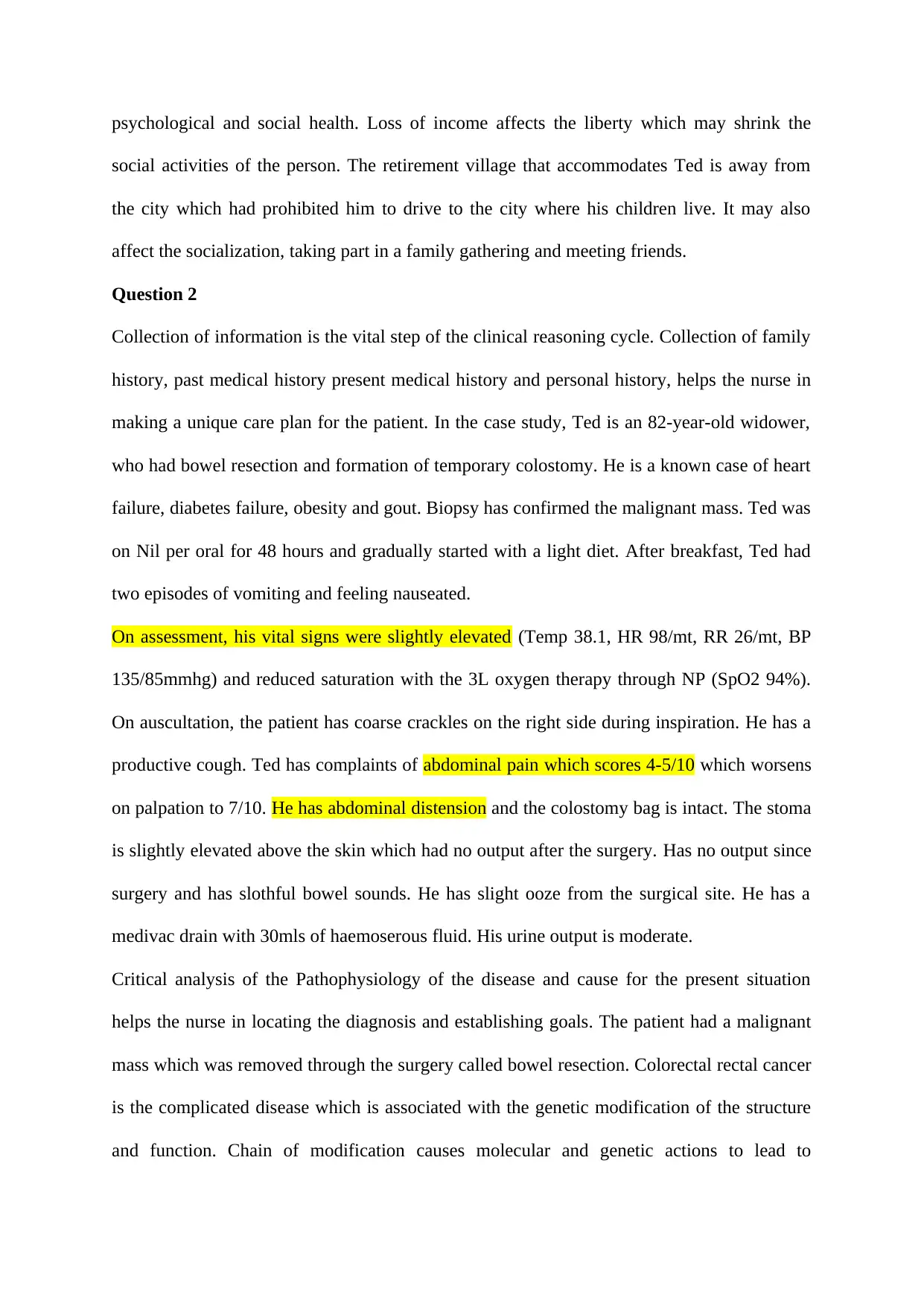
psychological and social health. Loss of income affects the liberty which may shrink the
social activities of the person. The retirement village that accommodates Ted is away from
the city which had prohibited him to drive to the city where his children live. It may also
affect the socialization, taking part in a family gathering and meeting friends.
Question 2
Collection of information is the vital step of the clinical reasoning cycle. Collection of family
history, past medical history present medical history and personal history, helps the nurse in
making a unique care plan for the patient. In the case study, Ted is an 82-year-old widower,
who had bowel resection and formation of temporary colostomy. He is a known case of heart
failure, diabetes failure, obesity and gout. Biopsy has confirmed the malignant mass. Ted was
on Nil per oral for 48 hours and gradually started with a light diet. After breakfast, Ted had
two episodes of vomiting and feeling nauseated.
On assessment, his vital signs were slightly elevated (Temp 38.1, HR 98/mt, RR 26/mt, BP
135/85mmhg) and reduced saturation with the 3L oxygen therapy through NP (SpO2 94%).
On auscultation, the patient has coarse crackles on the right side during inspiration. He has a
productive cough. Ted has complaints of abdominal pain which scores 4-5/10 which worsens
on palpation to 7/10. He has abdominal distension and the colostomy bag is intact. The stoma
is slightly elevated above the skin which had no output after the surgery. Has no output since
surgery and has slothful bowel sounds. He has slight ooze from the surgical site. He has a
medivac drain with 30mls of haemoserous fluid. His urine output is moderate.
Critical analysis of the Pathophysiology of the disease and cause for the present situation
helps the nurse in locating the diagnosis and establishing goals. The patient had a malignant
mass which was removed through the surgery called bowel resection. Colorectal rectal cancer
is the complicated disease which is associated with the genetic modification of the structure
and function. Chain of modification causes molecular and genetic actions to lead to
social activities of the person. The retirement village that accommodates Ted is away from
the city which had prohibited him to drive to the city where his children live. It may also
affect the socialization, taking part in a family gathering and meeting friends.
Question 2
Collection of information is the vital step of the clinical reasoning cycle. Collection of family
history, past medical history present medical history and personal history, helps the nurse in
making a unique care plan for the patient. In the case study, Ted is an 82-year-old widower,
who had bowel resection and formation of temporary colostomy. He is a known case of heart
failure, diabetes failure, obesity and gout. Biopsy has confirmed the malignant mass. Ted was
on Nil per oral for 48 hours and gradually started with a light diet. After breakfast, Ted had
two episodes of vomiting and feeling nauseated.
On assessment, his vital signs were slightly elevated (Temp 38.1, HR 98/mt, RR 26/mt, BP
135/85mmhg) and reduced saturation with the 3L oxygen therapy through NP (SpO2 94%).
On auscultation, the patient has coarse crackles on the right side during inspiration. He has a
productive cough. Ted has complaints of abdominal pain which scores 4-5/10 which worsens
on palpation to 7/10. He has abdominal distension and the colostomy bag is intact. The stoma
is slightly elevated above the skin which had no output after the surgery. Has no output since
surgery and has slothful bowel sounds. He has slight ooze from the surgical site. He has a
medivac drain with 30mls of haemoserous fluid. His urine output is moderate.
Critical analysis of the Pathophysiology of the disease and cause for the present situation
helps the nurse in locating the diagnosis and establishing goals. The patient had a malignant
mass which was removed through the surgery called bowel resection. Colorectal rectal cancer
is the complicated disease which is associated with the genetic modification of the structure
and function. Chain of modification causes molecular and genetic actions to lead to
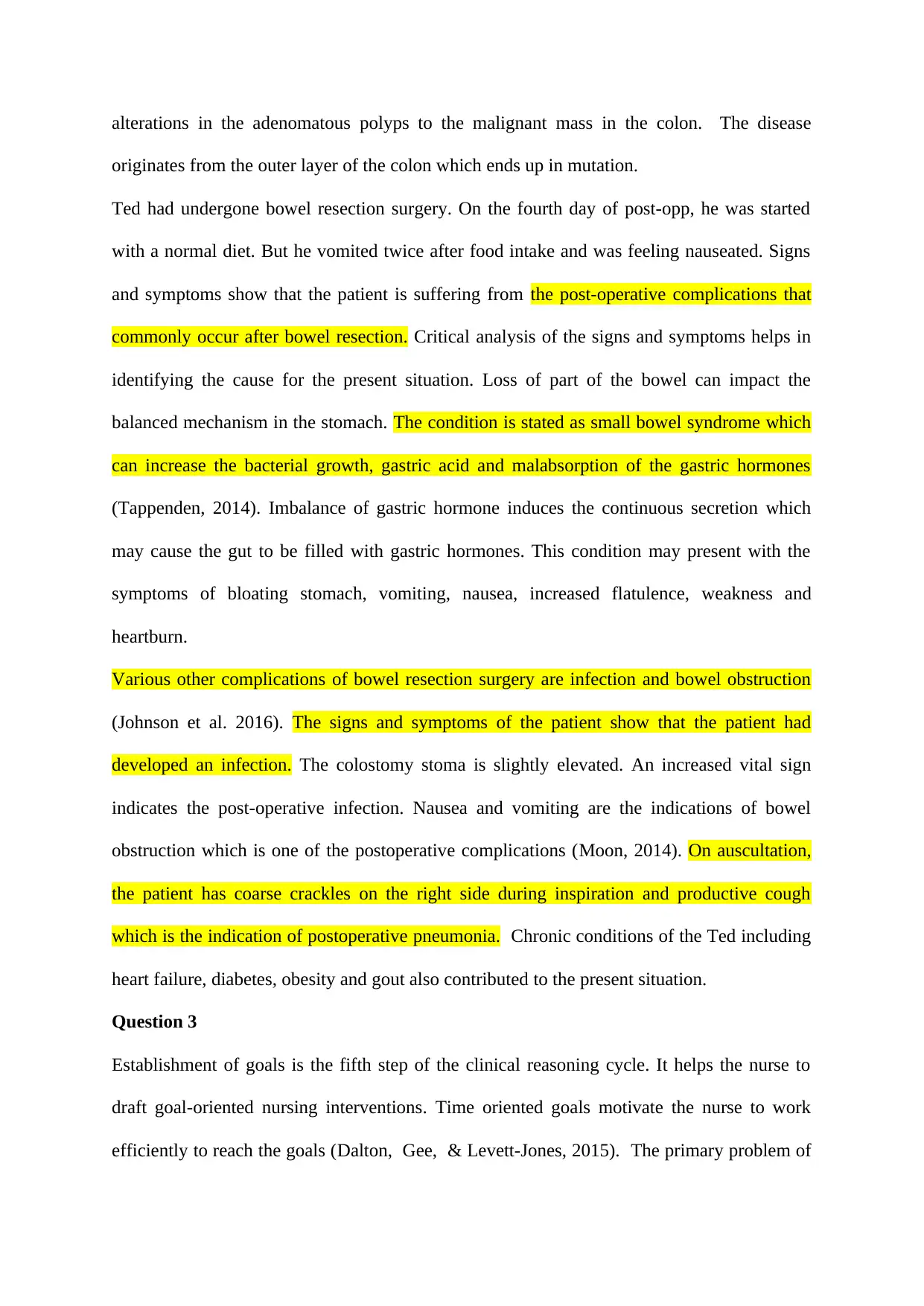
alterations in the adenomatous polyps to the malignant mass in the colon. The disease
originates from the outer layer of the colon which ends up in mutation.
Ted had undergone bowel resection surgery. On the fourth day of post-opp, he was started
with a normal diet. But he vomited twice after food intake and was feeling nauseated. Signs
and symptoms show that the patient is suffering from the post-operative complications that
commonly occur after bowel resection. Critical analysis of the signs and symptoms helps in
identifying the cause for the present situation. Loss of part of the bowel can impact the
balanced mechanism in the stomach. The condition is stated as small bowel syndrome which
can increase the bacterial growth, gastric acid and malabsorption of the gastric hormones
(Tappenden, 2014). Imbalance of gastric hormone induces the continuous secretion which
may cause the gut to be filled with gastric hormones. This condition may present with the
symptoms of bloating stomach, vomiting, nausea, increased flatulence, weakness and
heartburn.
Various other complications of bowel resection surgery are infection and bowel obstruction
(Johnson et al. 2016). The signs and symptoms of the patient show that the patient had
developed an infection. The colostomy stoma is slightly elevated. An increased vital sign
indicates the post-operative infection. Nausea and vomiting are the indications of bowel
obstruction which is one of the postoperative complications (Moon, 2014). On auscultation,
the patient has coarse crackles on the right side during inspiration and productive cough
which is the indication of postoperative pneumonia. Chronic conditions of the Ted including
heart failure, diabetes, obesity and gout also contributed to the present situation.
Question 3
Establishment of goals is the fifth step of the clinical reasoning cycle. It helps the nurse to
draft goal-oriented nursing interventions. Time oriented goals motivate the nurse to work
efficiently to reach the goals (Dalton, Gee, & Levett-Jones, 2015). The primary problem of
originates from the outer layer of the colon which ends up in mutation.
Ted had undergone bowel resection surgery. On the fourth day of post-opp, he was started
with a normal diet. But he vomited twice after food intake and was feeling nauseated. Signs
and symptoms show that the patient is suffering from the post-operative complications that
commonly occur after bowel resection. Critical analysis of the signs and symptoms helps in
identifying the cause for the present situation. Loss of part of the bowel can impact the
balanced mechanism in the stomach. The condition is stated as small bowel syndrome which
can increase the bacterial growth, gastric acid and malabsorption of the gastric hormones
(Tappenden, 2014). Imbalance of gastric hormone induces the continuous secretion which
may cause the gut to be filled with gastric hormones. This condition may present with the
symptoms of bloating stomach, vomiting, nausea, increased flatulence, weakness and
heartburn.
Various other complications of bowel resection surgery are infection and bowel obstruction
(Johnson et al. 2016). The signs and symptoms of the patient show that the patient had
developed an infection. The colostomy stoma is slightly elevated. An increased vital sign
indicates the post-operative infection. Nausea and vomiting are the indications of bowel
obstruction which is one of the postoperative complications (Moon, 2014). On auscultation,
the patient has coarse crackles on the right side during inspiration and productive cough
which is the indication of postoperative pneumonia. Chronic conditions of the Ted including
heart failure, diabetes, obesity and gout also contributed to the present situation.
Question 3
Establishment of goals is the fifth step of the clinical reasoning cycle. It helps the nurse to
draft goal-oriented nursing interventions. Time oriented goals motivate the nurse to work
efficiently to reach the goals (Dalton, Gee, & Levett-Jones, 2015). The primary problem of
⊘ This is a preview!⊘
Do you want full access?
Subscribe today to unlock all pages.

Trusted by 1+ million students worldwide
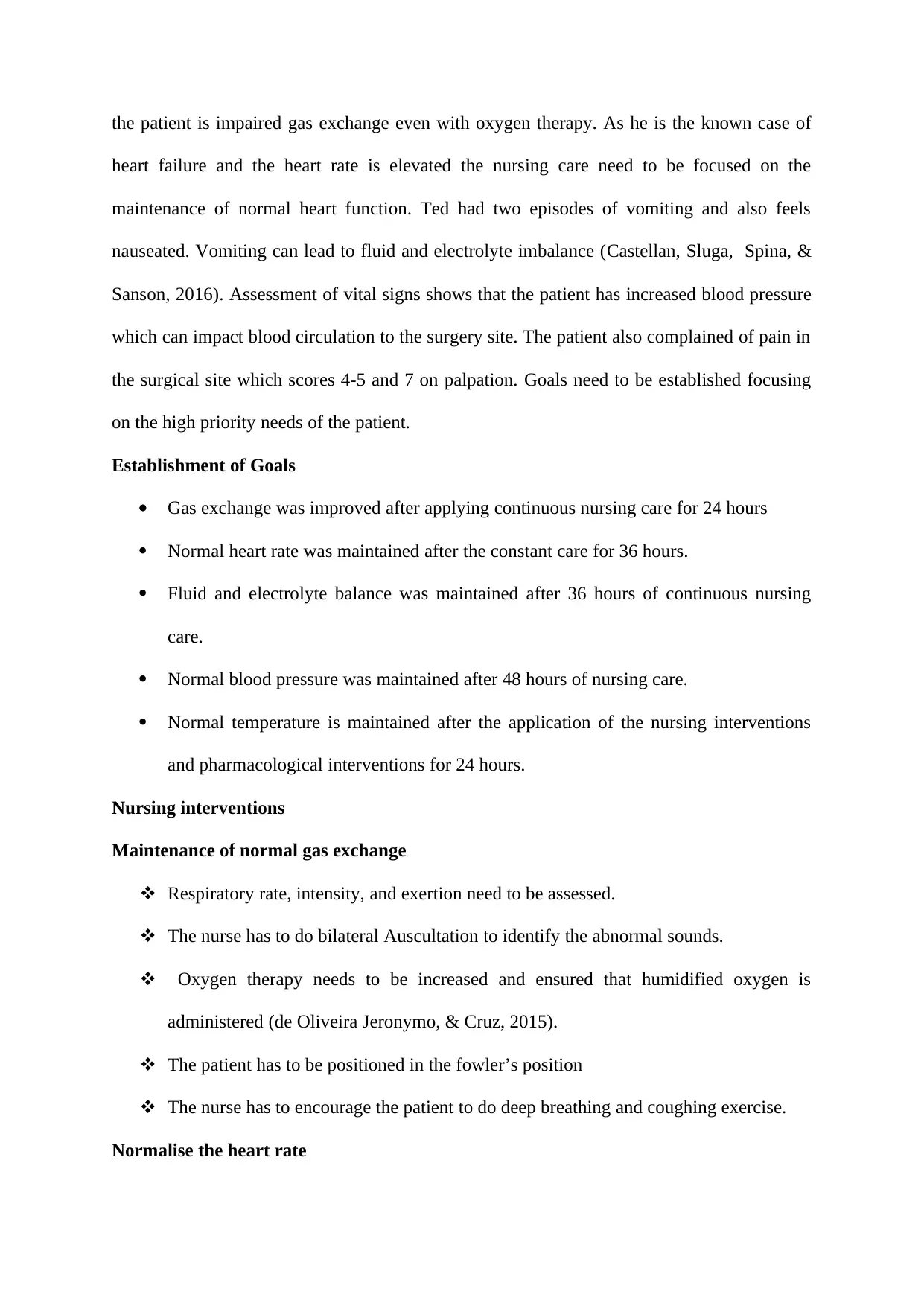
the patient is impaired gas exchange even with oxygen therapy. As he is the known case of
heart failure and the heart rate is elevated the nursing care need to be focused on the
maintenance of normal heart function. Ted had two episodes of vomiting and also feels
nauseated. Vomiting can lead to fluid and electrolyte imbalance (Castellan, Sluga, Spina, &
Sanson, 2016). Assessment of vital signs shows that the patient has increased blood pressure
which can impact blood circulation to the surgery site. The patient also complained of pain in
the surgical site which scores 4-5 and 7 on palpation. Goals need to be established focusing
on the high priority needs of the patient.
Establishment of Goals
Gas exchange was improved after applying continuous nursing care for 24 hours
Normal heart rate was maintained after the constant care for 36 hours.
Fluid and electrolyte balance was maintained after 36 hours of continuous nursing
care.
Normal blood pressure was maintained after 48 hours of nursing care.
Normal temperature is maintained after the application of the nursing interventions
and pharmacological interventions for 24 hours.
Nursing interventions
Maintenance of normal gas exchange
Respiratory rate, intensity, and exertion need to be assessed.
The nurse has to do bilateral Auscultation to identify the abnormal sounds.
Oxygen therapy needs to be increased and ensured that humidified oxygen is
administered (de Oliveira Jeronymo, & Cruz, 2015).
The patient has to be positioned in the fowler’s position
The nurse has to encourage the patient to do deep breathing and coughing exercise.
Normalise the heart rate
heart failure and the heart rate is elevated the nursing care need to be focused on the
maintenance of normal heart function. Ted had two episodes of vomiting and also feels
nauseated. Vomiting can lead to fluid and electrolyte imbalance (Castellan, Sluga, Spina, &
Sanson, 2016). Assessment of vital signs shows that the patient has increased blood pressure
which can impact blood circulation to the surgery site. The patient also complained of pain in
the surgical site which scores 4-5 and 7 on palpation. Goals need to be established focusing
on the high priority needs of the patient.
Establishment of Goals
Gas exchange was improved after applying continuous nursing care for 24 hours
Normal heart rate was maintained after the constant care for 36 hours.
Fluid and electrolyte balance was maintained after 36 hours of continuous nursing
care.
Normal blood pressure was maintained after 48 hours of nursing care.
Normal temperature is maintained after the application of the nursing interventions
and pharmacological interventions for 24 hours.
Nursing interventions
Maintenance of normal gas exchange
Respiratory rate, intensity, and exertion need to be assessed.
The nurse has to do bilateral Auscultation to identify the abnormal sounds.
Oxygen therapy needs to be increased and ensured that humidified oxygen is
administered (de Oliveira Jeronymo, & Cruz, 2015).
The patient has to be positioned in the fowler’s position
The nurse has to encourage the patient to do deep breathing and coughing exercise.
Normalise the heart rate
Paraphrase This Document
Need a fresh take? Get an instant paraphrase of this document with our AI Paraphraser
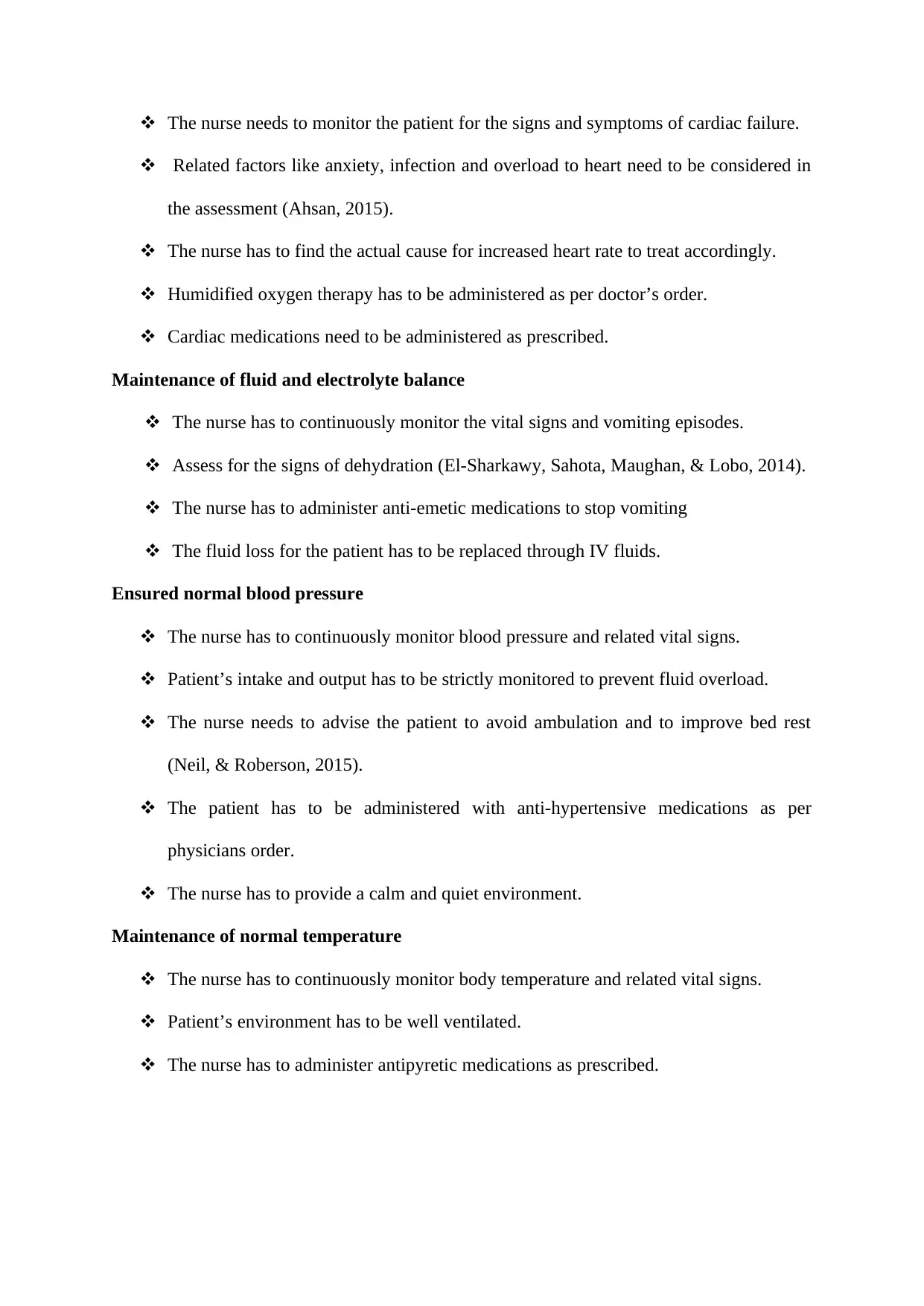
The nurse needs to monitor the patient for the signs and symptoms of cardiac failure.
Related factors like anxiety, infection and overload to heart need to be considered in
the assessment (Ahsan, 2015).
The nurse has to find the actual cause for increased heart rate to treat accordingly.
Humidified oxygen therapy has to be administered as per doctor’s order.
Cardiac medications need to be administered as prescribed.
Maintenance of fluid and electrolyte balance
The nurse has to continuously monitor the vital signs and vomiting episodes.
Assess for the signs of dehydration (El-Sharkawy, Sahota, Maughan, & Lobo, 2014).
The nurse has to administer anti-emetic medications to stop vomiting
The fluid loss for the patient has to be replaced through IV fluids.
Ensured normal blood pressure
The nurse has to continuously monitor blood pressure and related vital signs.
Patient’s intake and output has to be strictly monitored to prevent fluid overload.
The nurse needs to advise the patient to avoid ambulation and to improve bed rest
(Neil, & Roberson, 2015).
The patient has to be administered with anti-hypertensive medications as per
physicians order.
The nurse has to provide a calm and quiet environment.
Maintenance of normal temperature
The nurse has to continuously monitor body temperature and related vital signs.
Patient’s environment has to be well ventilated.
The nurse has to administer antipyretic medications as prescribed.
Related factors like anxiety, infection and overload to heart need to be considered in
the assessment (Ahsan, 2015).
The nurse has to find the actual cause for increased heart rate to treat accordingly.
Humidified oxygen therapy has to be administered as per doctor’s order.
Cardiac medications need to be administered as prescribed.
Maintenance of fluid and electrolyte balance
The nurse has to continuously monitor the vital signs and vomiting episodes.
Assess for the signs of dehydration (El-Sharkawy, Sahota, Maughan, & Lobo, 2014).
The nurse has to administer anti-emetic medications to stop vomiting
The fluid loss for the patient has to be replaced through IV fluids.
Ensured normal blood pressure
The nurse has to continuously monitor blood pressure and related vital signs.
Patient’s intake and output has to be strictly monitored to prevent fluid overload.
The nurse needs to advise the patient to avoid ambulation and to improve bed rest
(Neil, & Roberson, 2015).
The patient has to be administered with anti-hypertensive medications as per
physicians order.
The nurse has to provide a calm and quiet environment.
Maintenance of normal temperature
The nurse has to continuously monitor body temperature and related vital signs.
Patient’s environment has to be well ventilated.
The nurse has to administer antipyretic medications as prescribed.
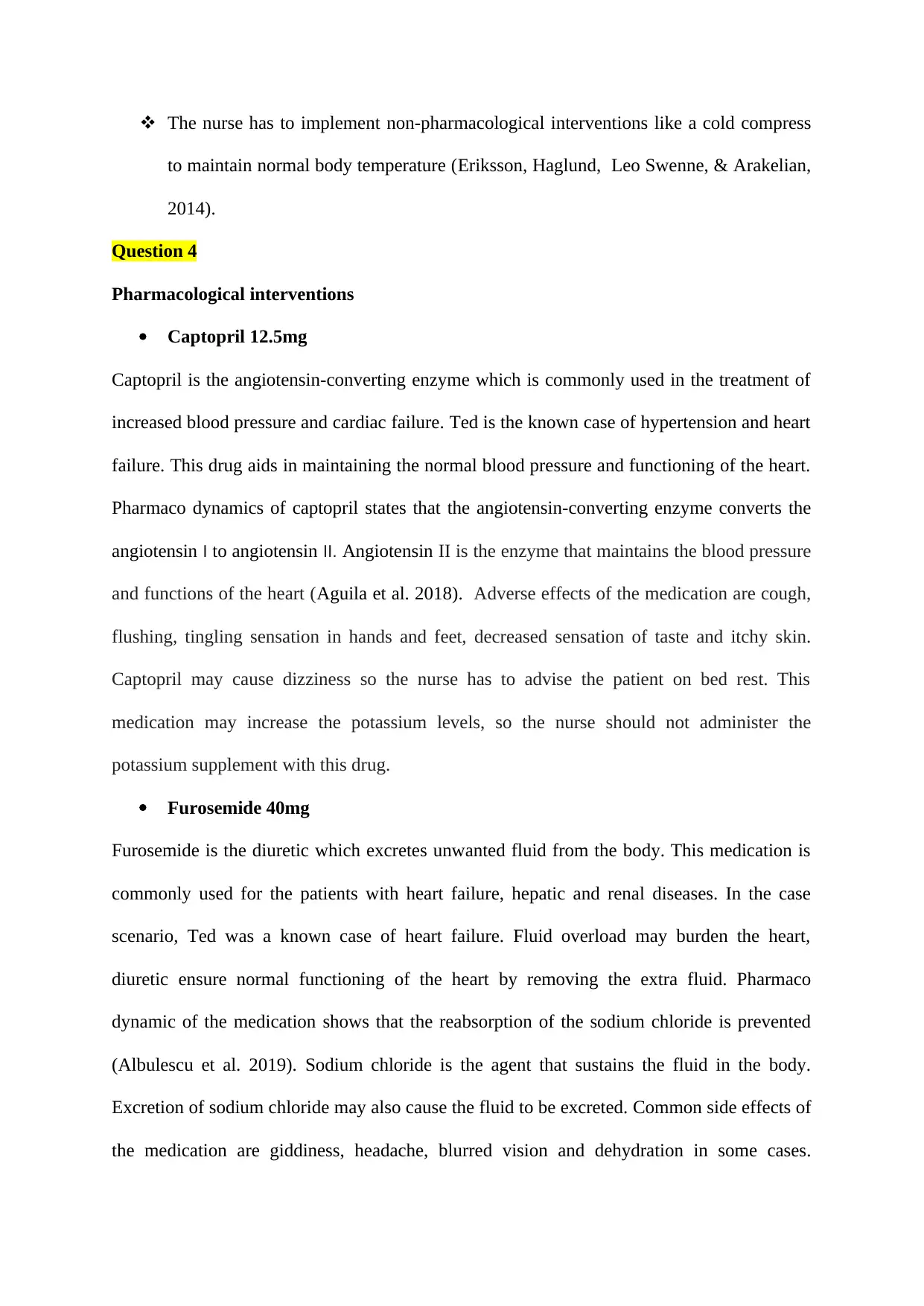
The nurse has to implement non-pharmacological interventions like a cold compress
to maintain normal body temperature (Eriksson, Haglund, Leo Swenne, & Arakelian,
2014).
Question 4
Pharmacological interventions
Captopril 12.5mg
Captopril is the angiotensin-converting enzyme which is commonly used in the treatment of
increased blood pressure and cardiac failure. Ted is the known case of hypertension and heart
failure. This drug aids in maintaining the normal blood pressure and functioning of the heart.
Pharmaco dynamics of captopril states that the angiotensin-converting enzyme converts the
angiotensin I to angiotensin II. Angiotensin II is the enzyme that maintains the blood pressure
and functions of the heart (Aguila et al. 2018). Adverse effects of the medication are cough,
flushing, tingling sensation in hands and feet, decreased sensation of taste and itchy skin.
Captopril may cause dizziness so the nurse has to advise the patient on bed rest. This
medication may increase the potassium levels, so the nurse should not administer the
potassium supplement with this drug.
Furosemide 40mg
Furosemide is the diuretic which excretes unwanted fluid from the body. This medication is
commonly used for the patients with heart failure, hepatic and renal diseases. In the case
scenario, Ted was a known case of heart failure. Fluid overload may burden the heart,
diuretic ensure normal functioning of the heart by removing the extra fluid. Pharmaco
dynamic of the medication shows that the reabsorption of the sodium chloride is prevented
(Albulescu et al. 2019). Sodium chloride is the agent that sustains the fluid in the body.
Excretion of sodium chloride may also cause the fluid to be excreted. Common side effects of
the medication are giddiness, headache, blurred vision and dehydration in some cases.
to maintain normal body temperature (Eriksson, Haglund, Leo Swenne, & Arakelian,
2014).
Question 4
Pharmacological interventions
Captopril 12.5mg
Captopril is the angiotensin-converting enzyme which is commonly used in the treatment of
increased blood pressure and cardiac failure. Ted is the known case of hypertension and heart
failure. This drug aids in maintaining the normal blood pressure and functioning of the heart.
Pharmaco dynamics of captopril states that the angiotensin-converting enzyme converts the
angiotensin I to angiotensin II. Angiotensin II is the enzyme that maintains the blood pressure
and functions of the heart (Aguila et al. 2018). Adverse effects of the medication are cough,
flushing, tingling sensation in hands and feet, decreased sensation of taste and itchy skin.
Captopril may cause dizziness so the nurse has to advise the patient on bed rest. This
medication may increase the potassium levels, so the nurse should not administer the
potassium supplement with this drug.
Furosemide 40mg
Furosemide is the diuretic which excretes unwanted fluid from the body. This medication is
commonly used for the patients with heart failure, hepatic and renal diseases. In the case
scenario, Ted was a known case of heart failure. Fluid overload may burden the heart,
diuretic ensure normal functioning of the heart by removing the extra fluid. Pharmaco
dynamic of the medication shows that the reabsorption of the sodium chloride is prevented
(Albulescu et al. 2019). Sodium chloride is the agent that sustains the fluid in the body.
Excretion of sodium chloride may also cause the fluid to be excreted. Common side effects of
the medication are giddiness, headache, blurred vision and dehydration in some cases.
⊘ This is a preview!⊘
Do you want full access?
Subscribe today to unlock all pages.

Trusted by 1+ million students worldwide
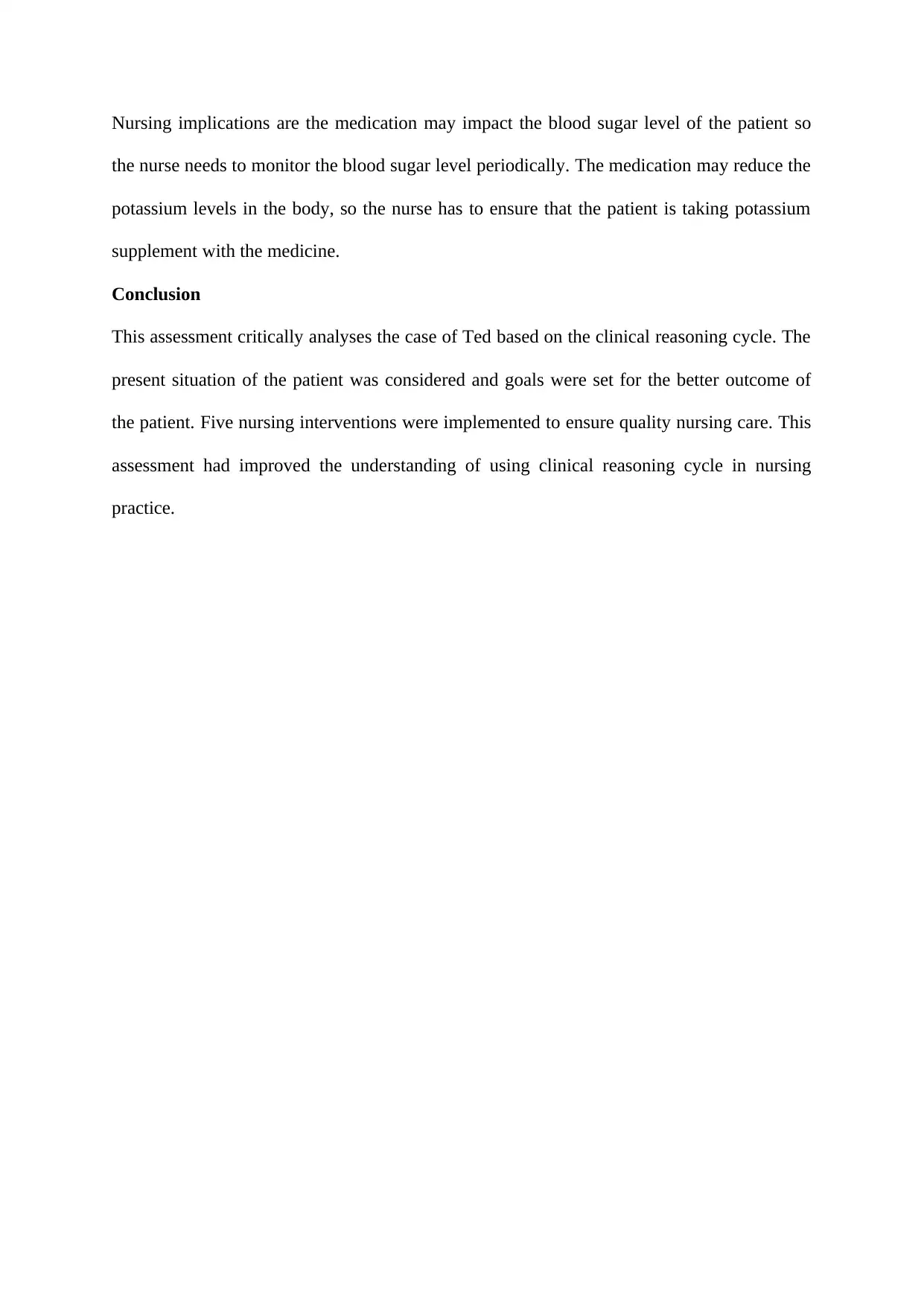
Nursing implications are the medication may impact the blood sugar level of the patient so
the nurse needs to monitor the blood sugar level periodically. The medication may reduce the
potassium levels in the body, so the nurse has to ensure that the patient is taking potassium
supplement with the medicine.
Conclusion
This assessment critically analyses the case of Ted based on the clinical reasoning cycle. The
present situation of the patient was considered and goals were set for the better outcome of
the patient. Five nursing interventions were implemented to ensure quality nursing care. This
assessment had improved the understanding of using clinical reasoning cycle in nursing
practice.
the nurse needs to monitor the blood sugar level periodically. The medication may reduce the
potassium levels in the body, so the nurse has to ensure that the patient is taking potassium
supplement with the medicine.
Conclusion
This assessment critically analyses the case of Ted based on the clinical reasoning cycle. The
present situation of the patient was considered and goals were set for the better outcome of
the patient. Five nursing interventions were implemented to ensure quality nursing care. This
assessment had improved the understanding of using clinical reasoning cycle in nursing
practice.
Paraphrase This Document
Need a fresh take? Get an instant paraphrase of this document with our AI Paraphraser
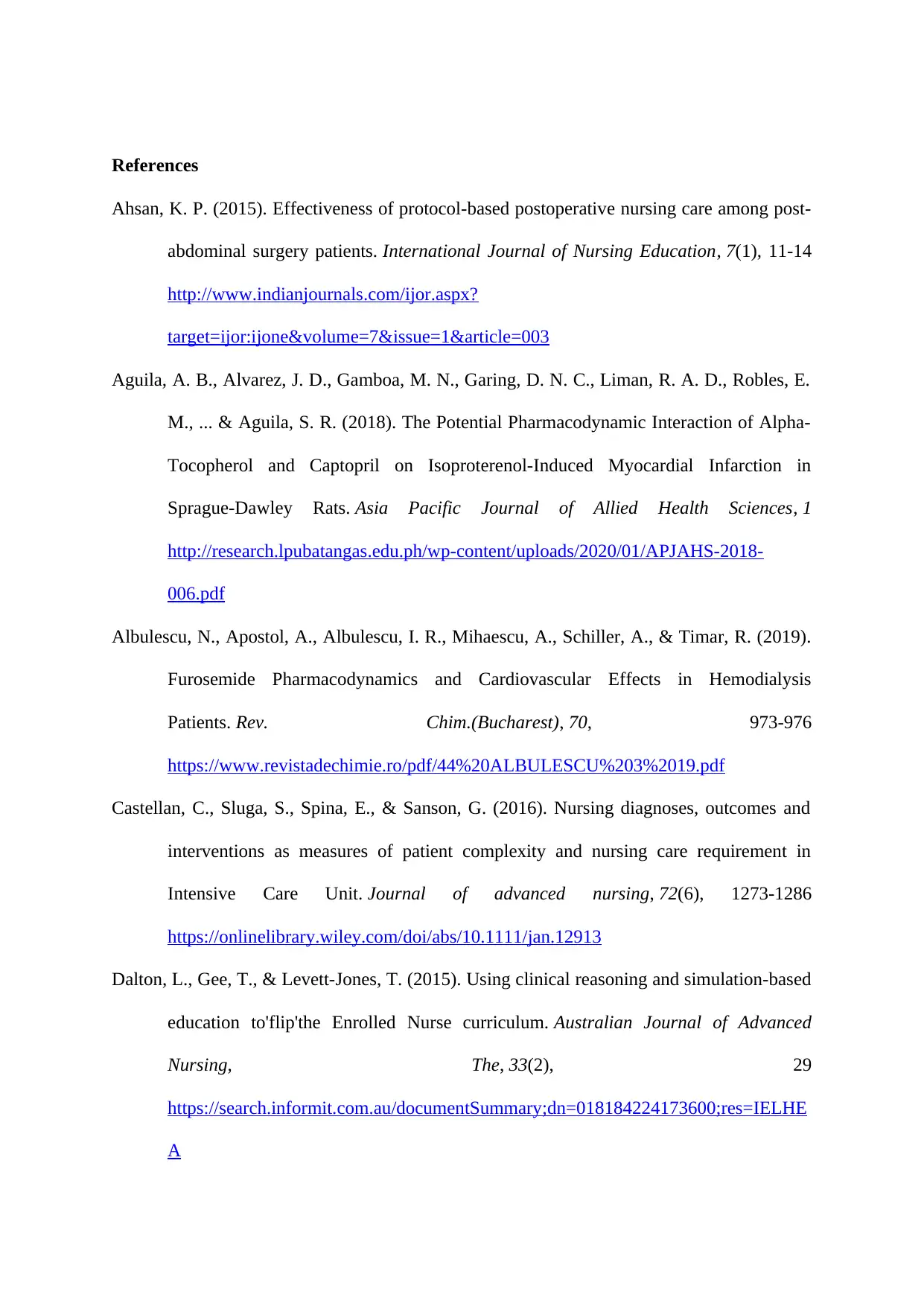
References
Ahsan, K. P. (2015). Effectiveness of protocol-based postoperative nursing care among post-
abdominal surgery patients. International Journal of Nursing Education, 7(1), 11-14
http://www.indianjournals.com/ijor.aspx?
target=ijor:ijone&volume=7&issue=1&article=003
Aguila, A. B., Alvarez, J. D., Gamboa, M. N., Garing, D. N. C., Liman, R. A. D., Robles, E.
M., ... & Aguila, S. R. (2018). The Potential Pharmacodynamic Interaction of Alpha-
Tocopherol and Captopril on Isoproterenol-Induced Myocardial Infarction in
Sprague-Dawley Rats. Asia Pacific Journal of Allied Health Sciences, 1
http://research.lpubatangas.edu.ph/wp-content/uploads/2020/01/APJAHS-2018-
006.pdf
Albulescu, N., Apostol, A., Albulescu, I. R., Mihaescu, A., Schiller, A., & Timar, R. (2019).
Furosemide Pharmacodynamics and Cardiovascular Effects in Hemodialysis
Patients. Rev. Chim.(Bucharest), 70, 973-976
https://www.revistadechimie.ro/pdf/44%20ALBULESCU%203%2019.pdf
Castellan, C., Sluga, S., Spina, E., & Sanson, G. (2016). Nursing diagnoses, outcomes and
interventions as measures of patient complexity and nursing care requirement in
Intensive Care Unit. Journal of advanced nursing, 72(6), 1273-1286
https://onlinelibrary.wiley.com/doi/abs/10.1111/jan.12913
Dalton, L., Gee, T., & Levett-Jones, T. (2015). Using clinical reasoning and simulation-based
education to'flip'the Enrolled Nurse curriculum. Australian Journal of Advanced
Nursing, The, 33(2), 29
https://search.informit.com.au/documentSummary;dn=018184224173600;res=IELHE
A
Ahsan, K. P. (2015). Effectiveness of protocol-based postoperative nursing care among post-
abdominal surgery patients. International Journal of Nursing Education, 7(1), 11-14
http://www.indianjournals.com/ijor.aspx?
target=ijor:ijone&volume=7&issue=1&article=003
Aguila, A. B., Alvarez, J. D., Gamboa, M. N., Garing, D. N. C., Liman, R. A. D., Robles, E.
M., ... & Aguila, S. R. (2018). The Potential Pharmacodynamic Interaction of Alpha-
Tocopherol and Captopril on Isoproterenol-Induced Myocardial Infarction in
Sprague-Dawley Rats. Asia Pacific Journal of Allied Health Sciences, 1
http://research.lpubatangas.edu.ph/wp-content/uploads/2020/01/APJAHS-2018-
006.pdf
Albulescu, N., Apostol, A., Albulescu, I. R., Mihaescu, A., Schiller, A., & Timar, R. (2019).
Furosemide Pharmacodynamics and Cardiovascular Effects in Hemodialysis
Patients. Rev. Chim.(Bucharest), 70, 973-976
https://www.revistadechimie.ro/pdf/44%20ALBULESCU%203%2019.pdf
Castellan, C., Sluga, S., Spina, E., & Sanson, G. (2016). Nursing diagnoses, outcomes and
interventions as measures of patient complexity and nursing care requirement in
Intensive Care Unit. Journal of advanced nursing, 72(6), 1273-1286
https://onlinelibrary.wiley.com/doi/abs/10.1111/jan.12913
Dalton, L., Gee, T., & Levett-Jones, T. (2015). Using clinical reasoning and simulation-based
education to'flip'the Enrolled Nurse curriculum. Australian Journal of Advanced
Nursing, The, 33(2), 29
https://search.informit.com.au/documentSummary;dn=018184224173600;res=IELHE
A
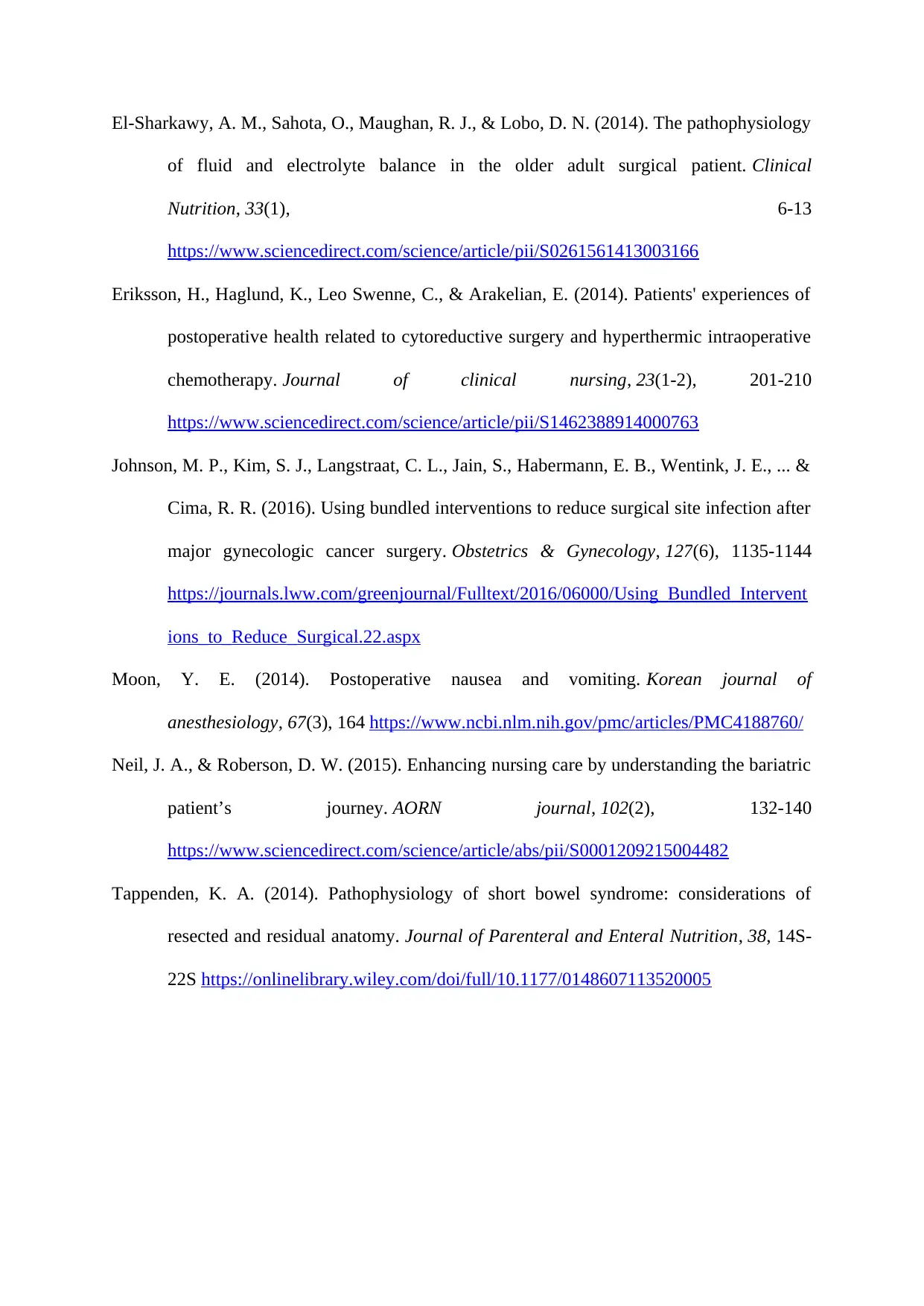
El-Sharkawy, A. M., Sahota, O., Maughan, R. J., & Lobo, D. N. (2014). The pathophysiology
of fluid and electrolyte balance in the older adult surgical patient. Clinical
Nutrition, 33(1), 6-13
https://www.sciencedirect.com/science/article/pii/S0261561413003166
Eriksson, H., Haglund, K., Leo Swenne, C., & Arakelian, E. (2014). Patients' experiences of
postoperative health related to cytoreductive surgery and hyperthermic intraoperative
chemotherapy. Journal of clinical nursing, 23(1-2), 201-210
https://www.sciencedirect.com/science/article/pii/S1462388914000763
Johnson, M. P., Kim, S. J., Langstraat, C. L., Jain, S., Habermann, E. B., Wentink, J. E., ... &
Cima, R. R. (2016). Using bundled interventions to reduce surgical site infection after
major gynecologic cancer surgery. Obstetrics & Gynecology, 127(6), 1135-1144
https://journals.lww.com/greenjournal/Fulltext/2016/06000/Using_Bundled_Intervent
ions_to_Reduce_Surgical.22.aspx
Moon, Y. E. (2014). Postoperative nausea and vomiting. Korean journal of
anesthesiology, 67(3), 164 https://www.ncbi.nlm.nih.gov/pmc/articles/PMC4188760/
Neil, J. A., & Roberson, D. W. (2015). Enhancing nursing care by understanding the bariatric
patient’s journey. AORN journal, 102(2), 132-140
https://www.sciencedirect.com/science/article/abs/pii/S0001209215004482
Tappenden, K. A. (2014). Pathophysiology of short bowel syndrome: considerations of
resected and residual anatomy. Journal of Parenteral and Enteral Nutrition, 38, 14S-
22S https://onlinelibrary.wiley.com/doi/full/10.1177/0148607113520005
of fluid and electrolyte balance in the older adult surgical patient. Clinical
Nutrition, 33(1), 6-13
https://www.sciencedirect.com/science/article/pii/S0261561413003166
Eriksson, H., Haglund, K., Leo Swenne, C., & Arakelian, E. (2014). Patients' experiences of
postoperative health related to cytoreductive surgery and hyperthermic intraoperative
chemotherapy. Journal of clinical nursing, 23(1-2), 201-210
https://www.sciencedirect.com/science/article/pii/S1462388914000763
Johnson, M. P., Kim, S. J., Langstraat, C. L., Jain, S., Habermann, E. B., Wentink, J. E., ... &
Cima, R. R. (2016). Using bundled interventions to reduce surgical site infection after
major gynecologic cancer surgery. Obstetrics & Gynecology, 127(6), 1135-1144
https://journals.lww.com/greenjournal/Fulltext/2016/06000/Using_Bundled_Intervent
ions_to_Reduce_Surgical.22.aspx
Moon, Y. E. (2014). Postoperative nausea and vomiting. Korean journal of
anesthesiology, 67(3), 164 https://www.ncbi.nlm.nih.gov/pmc/articles/PMC4188760/
Neil, J. A., & Roberson, D. W. (2015). Enhancing nursing care by understanding the bariatric
patient’s journey. AORN journal, 102(2), 132-140
https://www.sciencedirect.com/science/article/abs/pii/S0001209215004482
Tappenden, K. A. (2014). Pathophysiology of short bowel syndrome: considerations of
resected and residual anatomy. Journal of Parenteral and Enteral Nutrition, 38, 14S-
22S https://onlinelibrary.wiley.com/doi/full/10.1177/0148607113520005
⊘ This is a preview!⊘
Do you want full access?
Subscribe today to unlock all pages.

Trusted by 1+ million students worldwide
1 out of 9
Related Documents
Your All-in-One AI-Powered Toolkit for Academic Success.
+13062052269
info@desklib.com
Available 24*7 on WhatsApp / Email
![[object Object]](/_next/static/media/star-bottom.7253800d.svg)
Unlock your academic potential
Copyright © 2020–2025 A2Z Services. All Rights Reserved. Developed and managed by ZUCOL.




